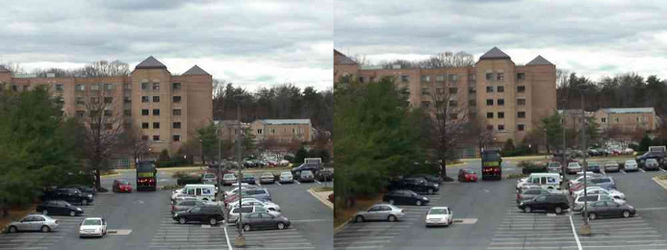Difference between revisions of "Example Video Stabilization"
From BoofCV
Jump to navigationJump to searchm |
m |
||
| Line 7: | Line 7: | ||
Video stabilization attempts to overlay more recent images on top of a keyframe. This makes it easier to identify objects which are moving relative to the background. | Video stabilization attempts to overlay more recent images on top of a keyframe. This makes it easier to identify objects which are moving relative to the background. | ||
Example File: [https://github.com/lessthanoptimal/BoofCV/blob/v0. | Example File: [https://github.com/lessthanoptimal/BoofCV/blob/v0.18/examples/src/boofcv/examples/geometry/ExampleVideoStabilization.java ExampleVideoStabilization.java] | ||
Concepts: | Concepts: | ||
Revision as of 13:15, 22 September 2014
Video stabilization attempts to overlay more recent images on top of a keyframe. This makes it easier to identify objects which are moving relative to the background.
Example File: ExampleVideoStabilization.java
Concepts:
- Image Stitching
- Image Stabilization
- 2D image motion
Relevant Applets:
Related Examples:
Example Code
/**
* Example of how to stabilizing a video sequence using StitchingFromMotion2D. Video stabilization is almost
* the same as creating a video mosaic and the code in this example is a tweaked version of the mosaic example.
* The differences are that the output size is the same as the input image size and that the origin is never changed.
*
* @author Peter Abeles
*/
public class ExampleVideoStabilization {
public static void main( String args[] ) {
// Configure the feature detector
ConfigGeneralDetector confDetector = new ConfigGeneralDetector();
confDetector.threshold = 10;
confDetector.maxFeatures = 300;
confDetector.radius = 2;
// Use a KLT tracker
PointTracker<ImageFloat32> tracker = FactoryPointTracker.klt(new int[]{1,2,4,8},confDetector,3,
ImageFloat32.class,ImageFloat32.class);
// This estimates the 2D image motion
// An Affine2D_F64 model also works quite well.
ImageMotion2D<ImageFloat32,Homography2D_F64> motion2D =
FactoryMotion2D.createMotion2D(200,3,2,30,0.6,0.5,false,tracker,new Homography2D_F64());
// wrap it so it output color images while estimating motion from gray
ImageMotion2D<MultiSpectral<ImageFloat32>,Homography2D_F64> motion2DColor =
new MsToGrayMotion2D<ImageFloat32,Homography2D_F64>(motion2D,ImageFloat32.class);
// This fuses the images together
StitchingFromMotion2D<MultiSpectral<ImageFloat32>,Homography2D_F64>
stabilize = FactoryMotion2D.createVideoStitchMS(0.5, motion2DColor, ImageFloat32.class);
// Load an image sequence
MediaManager media = DefaultMediaManager.INSTANCE;
String fileName = "../data/applet/shake.mjpeg";
SimpleImageSequence<MultiSpectral<ImageFloat32>> video =
media.openVideo(fileName, ImageType.ms(3, ImageFloat32.class));
MultiSpectral<ImageFloat32> frame = video.next();
// The output image size is the same as the input image size
stabilize.configure(frame.width, frame.height, null);
// process the first frame
stabilize.process(frame);
// Create the GUI for displaying the results + input image
ImageGridPanel gui = new ImageGridPanel(1,2);
gui.setImage(0,0,new BufferedImage(frame.width,frame.height,BufferedImage.TYPE_INT_RGB));
gui.setImage(0,1,new BufferedImage(frame.width,frame.height,BufferedImage.TYPE_INT_RGB));
gui.autoSetPreferredSize();
ShowImages.showWindow(gui,"Example Stabilization");
// process the video sequence one frame at a time
while( video.hasNext() ) {
if( !stabilize.process(video.next()) )
throw new RuntimeException("Don't forget to handle failures!");
// display the stabilized image
ConvertBufferedImage.convertTo(frame,gui.getImage(0, 0),true);
ConvertBufferedImage.convertTo(stabilize.getStitchedImage(), gui.getImage(0, 1),true);
gui.repaint();
// throttle the speed just in case it's on a fast computer
BoofMiscOps.pause(50);
}
}
}
